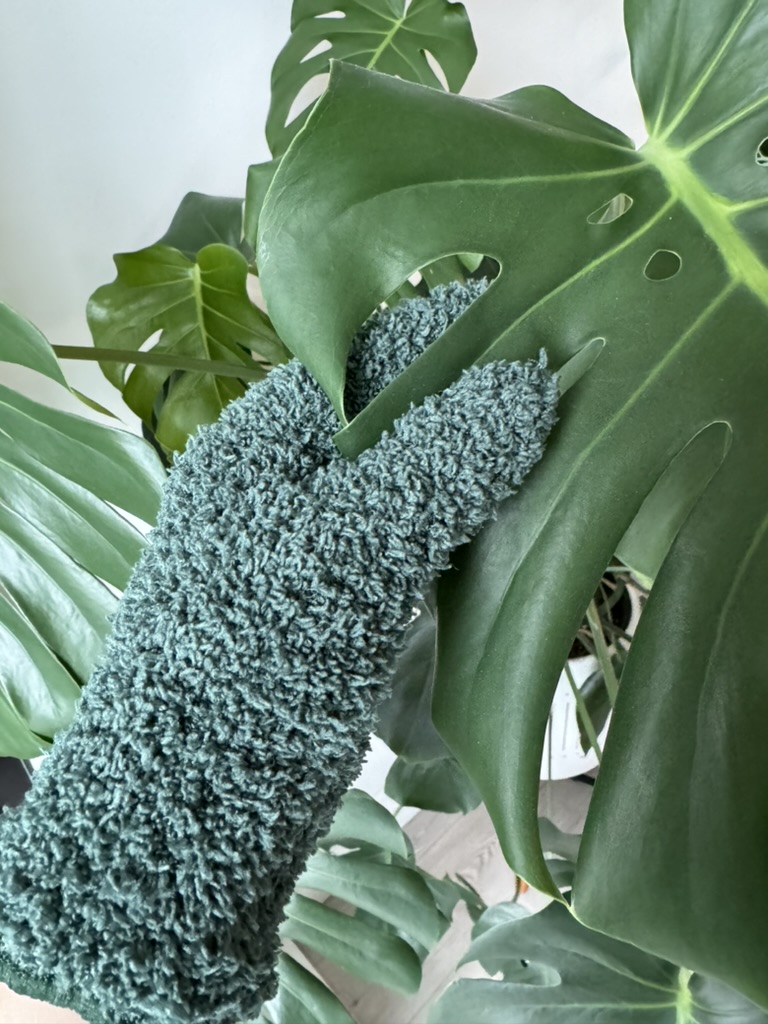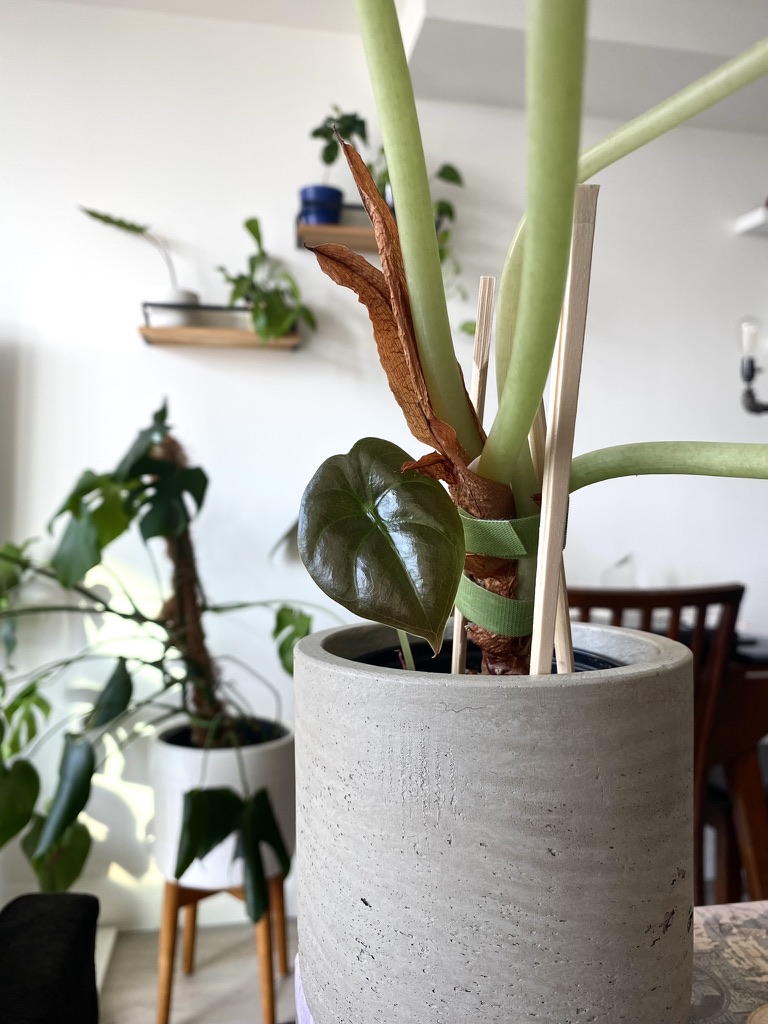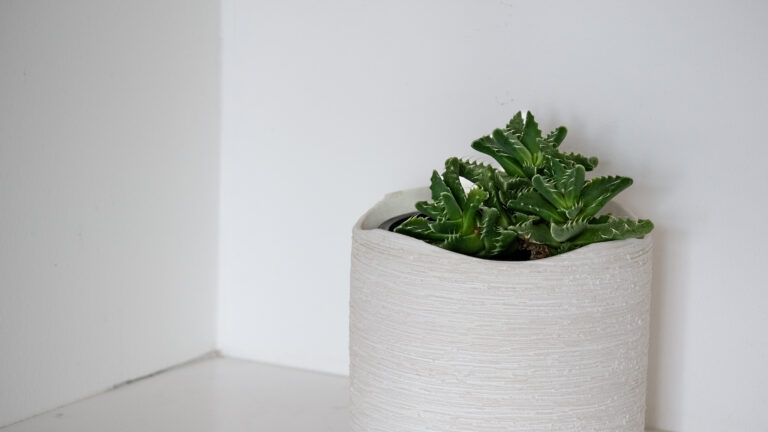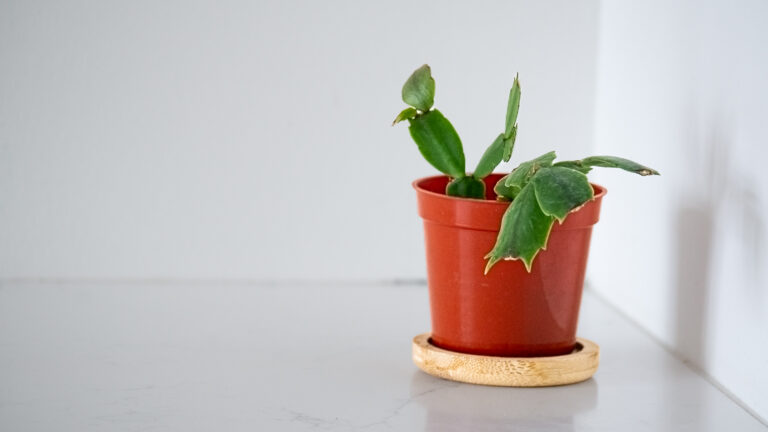Syngonium Strawberry Cream Arrowhead or Syngonium podophyllum ‘Strawberry Cream’ is a member of the Araceae family. There are more than 150 species of known species of the Syngonium genus within the Araceae family.
The Syngonium podophyllum is native to Mexico through Central America and as south as Brazil and Bolivia in South America.
Syngonium podophyllum ‘Strawberry Cream’ is referred to as the Syngonium Strawberry Cream Arrowhead Vine because of its creamy pink vining arrowhead shaped leaves.
Syngonium Strawberry Cream at a glance.
🪴 Appearance of Syngonium Strawberry Cream
The Syngonium Strawberry Cream grows in a compact pattern until the vines are long enough to cascade.
New foliage grows out of a light green stem. The backside of the leaf is a faded green and the front is a vibrant, light pink.
As the leaf matures, the pink darkens before it eventually fades to green. The center vein of the leaf remains pink.
☀️ What Light Does Syngonium Strawberry Cream Need?
Syngonium Strawberry Cream thrives in indirect, medium-bright light.
The more light it receives, the pinker the more vibrant the pink foliage will be.
I keep my Syngonium in the middle of a room with a south-west facing window. From first hand experience, I have seen how the pink is more vibrant the closer I have it to the window.

🌡️ Temperature & Humidity 🌫️
Syngonium Strawberry Cream prefers a temperature between 15° – 26°C (60°- 80°F).
They also prefer average household humidity levels of 40-60%.
I keep my Syngonium in a room with a Levoit Humidifier.
I use my humidifier to ensure the humidity levels in my apartment stays between 40% and 60%. Since I live in Canada and the winters can be very dry, the humidity can drop below 30% humidity, so its helpful to set the humidity at about 45% or 50% in this season to keep all of my plants happy.
🌱 How Does the Syngonium Strawberry Cream Grow?
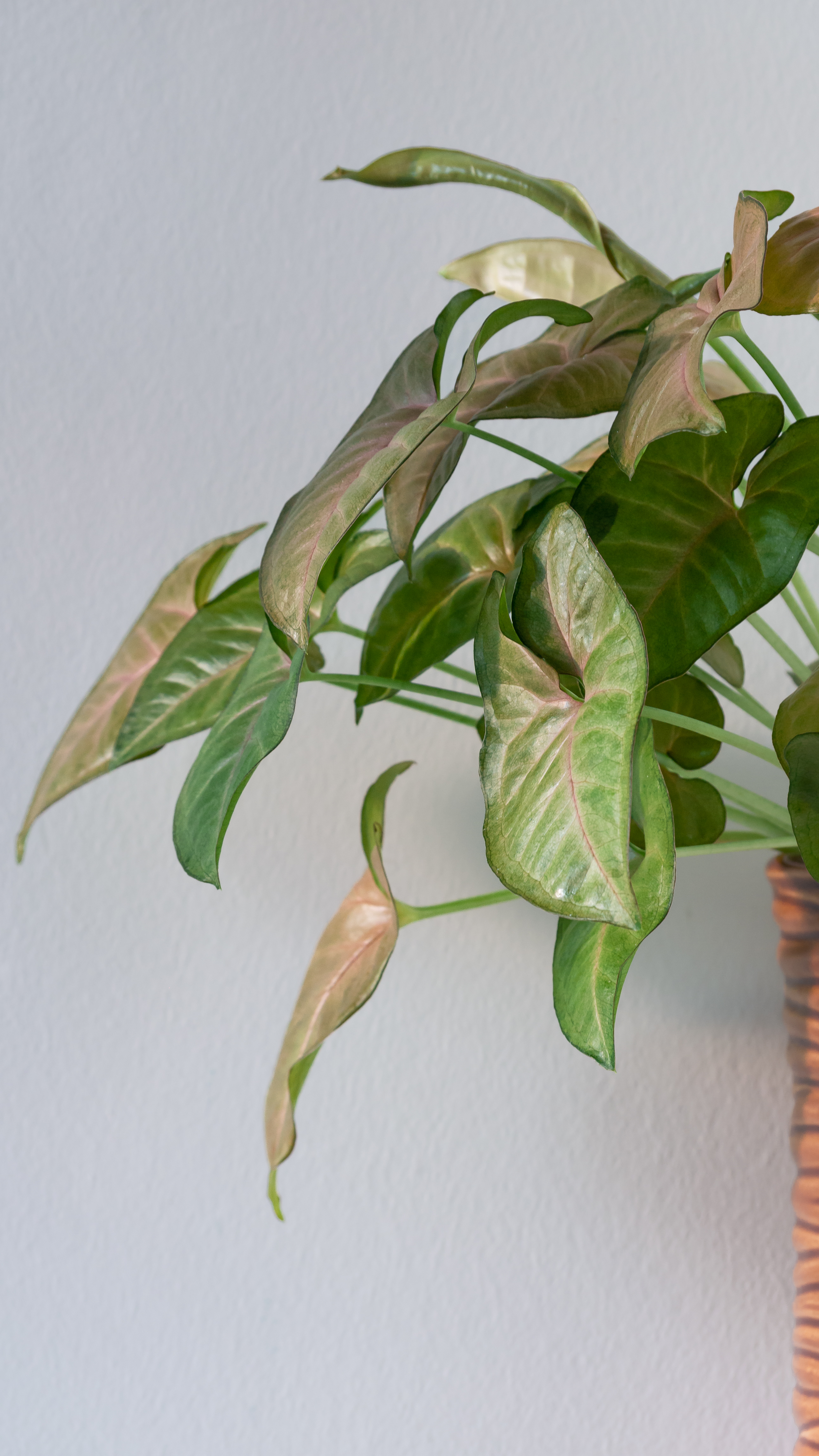
Syngonium Strawberry Cream can grow up to 6 feet as a houseplant.
As this is a vining plant, you can use a coco coir pole or some type of stake to encourage your vine to grow upwards instead of cascading.
New foliage grows out of the petiole. it is wrapped and light green on the outside, with a vibrant creamy pink on the inside. As the foliage ages, the pink darkens and eventually fades to a lighter green with the pink only visible in the midrib (center vein) area.
🪴 Repotting
Watch the video below on how to repot a Syngonium.
- Remove plant from old pot
- Detangle roots
- Add Syngonium to a new, larger pot (with a drainage hole) partially filled with a well-draining potting mix
- Add additional soil around the plant until the pot is filled (about 1″-2″ lower than the top of the pot)
- Make sure the plant is secure and water it
🌸 Does the Syngonium Strawberry Cream Bloom?
As a houseplant, your Syngonium Strawberry Cream is not likely to flower.
✂️ How to Propagate Syngonium Strawberry Cream?
The easiest way to start a new Syngonium Strawberry Cream is by division, but the most popular way is by cuttings.
Division
Division only works if you have multiple Syngoniums potted in one pot. If this applies to you, remove the entire plant from the pot, gently separate the plants, and plant the individual plants into their own planters with a well draining soil. Make sure you water the newly divided plants and place them in a bright location with indirect light.
Cuttings
For Cuttings, choose a section from a healthy adult plant that has a stem, leaf, and node.
Using sterilized shears or scissors, cut just below the node. Nodes are where the roots will develop.
Next choose whether you would like to water propagate or soil propagate. I like water propagation because I can see when the roots are forming.
For water propagation take the Syngonium cutting and place it in your water vessel (I like propagation stations, but you can use a jar, vase, glass–anything that can hold water really). If the water starts to get murky, you will want to change out the water and put the plant back in. Otherwise it will potentially rot the stem and the plant won’t root. After the plant roots, and the roots are stable enough, plant your Syngonium cutting in soil.
With Soil propagation take the cutting and put it directly the planter with well draining soil and water it. You won’t be able to see if the plant is rooting in the soil, but if the plant eventually dies, you know it didn’t root successfully.
Patience is key with propagation. Give your new plant time to settle into its environment. Once you see new growth, you know your plant is well established.
💧 How Much Water Does the Syngonium Strawberry Cream Need?
The Syngonium Strawberry Cream likes to be watered when half dry (this typically happens weekly). To determine if your plant needs water, you can stick your finger in the soil (1 to 2 inches) and if it is dry, its ready for water! If you don’t want to get your hands dirty, you can try a moisture meter.
Before I potted this up into a new decorative pot with a drainage hole, I bottom watered this plant. When it was in a nursing pot, I I placed the pot on a tray and added water to the tray. The plant absorbs the water through the drainage holes and takes in what it needs. This is the easiest way to prevent overwatering which can lead to fungus gnats, root rot, or the death of your plant.
For top watering, it’s best to do so in a pot with drainage until water is flowing out of the hole. If your pot doesn’t have drainage, you might accidentally overwater your plant.
If you bottom water, it is still good to top water from time to time to make sure any built up minerals can wash through the plant. The water should drip out of the bottom of your drainage hole.
🪳 Pests & Problems 😔
Syngonium Strawberry Cream can face the following pests and problems.
🪳 Pests
- Mealy Bugs: these look like little white cotton balls on the Syngonium. You can remove these with your fingers if you catch them early enough, but I would use a cotton swab with a drop of Isopropyl alcohol and try to scrape them off the stem.
- Aphids: Aphids are small, insects that cluster under leaves and stems of the Syngonium. They can appear white, brown, black, gray, light green or yellow. If you see distortion, wilting or yellowing leaves, this can be a sign of aphids. You should be able to spray them off with a strong stream of water or using insecticidal soap.
- Spider Mites: If spider mites have taken to your plant, spray them with a mixture of neem oil, dish soap and water (or you can buy an insecticidal soap). I repeat this about once or twice a week (depending on the severity of infestation) for about a month. It’s also good to do this preventatively once a month or so. You will know you have spider mites if you see webbing and leaf damage. Learn how to eradicate Spider Mites.
- Thrips: these are little, dark bugs that look like dirt. They suck the life out of the leaves, and lay eggs within the tissue of the Syngonium’s leaves. As Thrips age, they can grow wings and infect other plants. I spray the plant with a mixture of neem oil, dish soap and water. I repeat this every few days to try and get both the pest and the eggs. Sometimes I just chop the affected leaf since they are hard to eradicate. Complete guide on how to get rid of thrips.
- Fungus gnats: Spray the plant with a mixture of neem oil, dish soap and water. I also let the soil dry out and add dryer sheets on top of the soil so the gnats can’t sense the moisture on the soil.
😔 Other Common Problems
- Overwatering: Root rot happens from overwatering your Syngonium with insufficient drainage. You can improve the drainage of your plant by ensuring your plant is potted in a planter with a drainage hole and using a well draining soil (something with a decent amount of perlite). You can also end up with yellowing leaves fungus gnats or fungal disease from overwatering.
- Yellowing Leaves: If you have a new leaf coming in, your plant is likely fine. Plants pull energy from older leaves to support new growth. But it can also indicate over- or under- watering or lighting issues.
- Underwatering: Even though Syngonium prefer to be underwatered over overwatered, you still have to remember to water it on a consistent schedule. Signs of underwatering an include leaves becoming shrivelled, discoloured or dry.
- Drooping Leaves: Your plant is likely thirsty. Just give it a little water and it should be as good as new.
- Scorched Leaves: With too much sun, your Syngonium can end up with crispy edges or bleaches leaves. Move your plant to somewhere with less sun.
- Inconsistent temperatures: Syngonium Strawberry Cream prefers stable temperatures and is sensitive to cold drafts. Damage from cold temperatures can lead to disease, discolouration, growth stagnation or death. You can prevent this by making sure your plant is not exposed to environments below the recommended temperatures.
☢️ Are Syngonium Strawberry Cream Toxic?
Syngonium Strawberry Cream is moderately toxic to humans and pets if ingested.
Syngonium Strawberry Cream Quick Care Guide
| Scientific Name | Syngonium podophyllum ‘Strawberry Cream’ |
| Nickname | Syngonium Strawberry Cream, Strawberry Cream Arrowhead Vine |
| Origins | Central and South America |
| Light | Indirect, medium-light |
| Temperature | 15°-26°C (preferred) |
| Humidity | Average humidity (40-60%) |
| Height | Up to 6 feet |
| Blooms | Rare for a houseplant |
| Propagate | Cuttings, Division |
| Water Frequency | When half-dry (likely once a week) |
| Pests | Mealy Bugs, Aphids, Spider Mites, Thrips, Fungus Gnats |
| Common Problems | Overwatering (root rot, yellowing leaves), underwatering (crispy tips, dropping leaves), Scorched leaves (too much sun), temperature stress (curling leaves, stunted growth) |
| Toxicity | Moderate (not safe when ingested) |
References
Below is a list of external sources I consulted while writing this post. This post is a mixture of my own experiences, and the external sources listed below:
Jomo Studio – Syngonium Strawberry Cream
Plantura – Syngonium Overview
DMP – Syngonium
Urban Tropicals – Arrowhead Syngonium
RHS – Syngonium Podophyllum
Greg App – Syngonium Strawberry Cream Propagation & Problems

